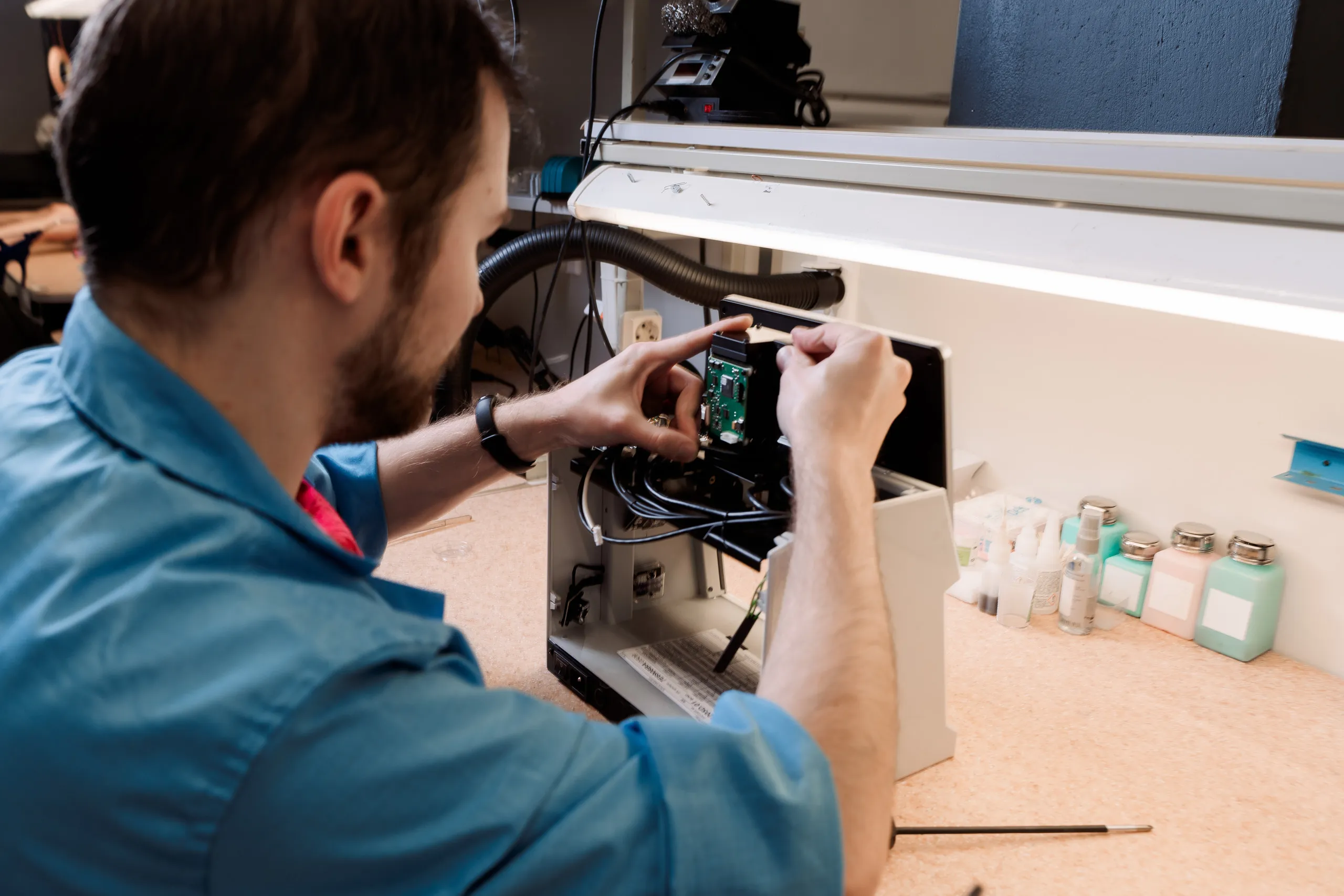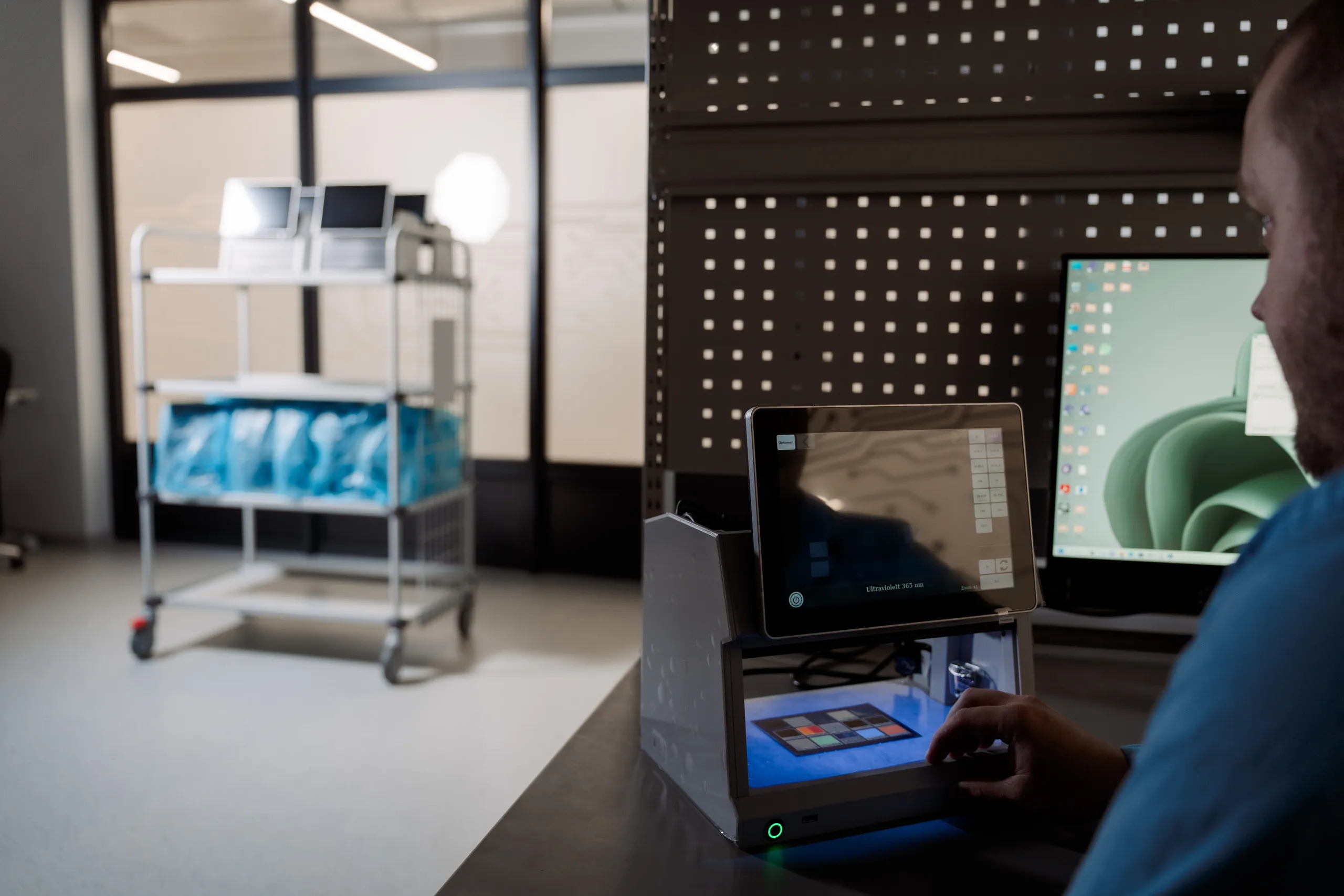Regula’s development center has recently changed location. It’s still in Daugavpils, Latvia, but it has moved to a new, larger office. Since the company’s business keeps growing, we need to intensify and expand our software and hardware R&D, as well as our forensic device manufacturing line. With this move, the Regula’s development center in Europe is as large as 3800 square meters, and the office building is twice as big as the former one.
New space—new capacity
We call our Latvian office the development center for a reason. Our full production cycle is 100% in-house—we create both our software and hardware solutions from scratch. And we’ve been doing it for over 30 years. This is our philosophy, and it allows us to guarantee quality at every stage.
As a global company, we provide ID verification and forensic solutions to more than 1,000 organizations and 80 border control authorities worldwide. This definitely encourages us, and at the same time, sets the bar high. So, to keep growing and helping businesses and government entities fight identity crime and create frictionless verification processes, we need to give our researchers, engineers, and developers more room for pioneering ideas. Both metaphorically and literally.
At Regula, we value and cherish our team of trusted experts and eager disruptors. We believe that true innovation comes from being open to the ideas of everyone in the company. And while designing our new development center, we stuck to that point.
Not only does Regula’s new Latvian office give more space for R&D and more opportunities for the exchange of ideas, it also reflects our new look, which was introduced at the end of 2022. This fresh brand identity is the metaphor of Regula’s invisible identity verification technologies, as well as the quality and unmatched accuracy that are embodied in our software and hardware solutions.
Come on in
Let us give you a little tour around our brand-new office and show how Regula’s software and hardware solutions for ID verification and forensic research are developed.

The new logo right at the entry to the Regula’s development center in Daugavpils, Latvia symbolizes engineering precision, because engineers are Regula’s backbone, and their scientific approach is in our DNA.

This shimmering map in the Latvian office highlights the countries where Regula’s software solutions and forensic devices are used.

Regula is all about quality and expertise. And this artwork is both tribute and stimulus to our R&D and our curious experts.

Regula’s success is teamwork-based. We encourage everyone in the company to express their ideas to the utmost and find the best solutions together.

However, ideas need to be fueled up. And people need breaks. For these purposes, we have dedicated spaces.

Our R&D is the heart of the Latvian office. It’s where the developers write code that empowers Regula’s ID verification software, both in our forensic devices and your smartphones.

Apart from software development, Regula’s office in Latvia is also the epicenter of hardware design and assembly. To produce a device, we use both hand labor and machinery.

We care about every tiny detail when it comes to manufacturing a device so that forensic experts can be sure of the high quality of the tools they rely on. For instance, here we mount electronic components on a printed circuit board using high-precision surface-mount technology.

At Regula’s device manufacturing facilities in Latvia, we create and assemble forensic devices for document authentication that are shipped to European states, the USA, Latin America, and the Middle East, as well as other countries.
“Our solutions help make justified decisions for thousands of law enforcement agencies and border control authorities, as well as large and not-so-large businesses throughout the world when it comes to identity verification and document authentication. The expansion of our European R&D and production facility will definitely allow us to meet the needs of our customers more relevantly and rapidly,” adds Ihar Kliashchou, Chief Technology Officer at Regula.
A sneak peek at forensic device production
The office in Daugavpils is also Regula’s production facility. Right here, all sorts of forensic devices for express and advanced document authentication come to life. Starting with the smallest forensic tools, like portable magnifiers or compact devices such as the Regula 1031, to full-size video spectral comparators like the Regula 4306, to high-resolution photospectral scanners such as the Regula 8880, the forensic equipment is 100% designed and assembled in this very development center.
If you have ever wondered how Regula high-precision forensic devices are manufactured, this is your chance to sneak into our production facilities. Let’s have a look at how a device is made.
Our example model will be the Regula 4205D, a desktop unit that enables thorough examination of all the security features of a document, as well as printing methods, and its luminescence in different light sources (ultraviolet, infrared, etc.). It’s a handy and user-friendly solution for first-line authentication of documents and banknotes.
First, the whole manufacturing process of the Regula 4205D is modeled on a computer to make it as precise as possible.

Computer-aided engineering helps prepare and adjust technical documentation, technological processes, and production mode.
Only after that do we move on to assembling, which starts with detail manufacturing that will make the future device. Metal cutting, lathe machining, milling, drilling, grinding and polishing, plastics processing—all this is the first step towards the completed Regula 4205D.

To make the device body precise, lightweight, stiff, and solid at the same time, we use different types of aluminum alloys, brass, copper, and stainless steel, as well as all sorts of plastic polymers.

Manufacturing some internal components of the Regula 4205D requires a high level of precision—up to 0.01 mm, because even the smallest deviation could affect the device’s functionality.

Some components of the Regula 4205D need to be treated after being manufactured, such as being bent to get the right shape, or powder coated, or galvanized.
Alongside manufacturing the device’s body details, electronic details are also made: electronics boards, cables and wires, LEDs, and all the other internal parts that make the Regula 4205D so powerful.

Electronic components, made and ready to be installed into a device.

Some elements are mounted by manual soldering.

To make sure our devices function as they should, we always double check. Like here, our specialist examines the quality of the electronic components’ connections after they are installed.
Then, it’s time to assemble it all together. For the Regula 4205D, it’s done manually.

First, we assemble the chassis of the Regula 4205D, and then proceed with mounting internal elements.

Adhesive tape is one of the solutions to fix the elements of the Regula 4205D in place.

Here you can see how the device’s wires are being connected to its camera.
The final step is tuning. To make sure the device will function impeccably, our experts check every detail and tune all the light sources and camera in accordance with industry standards.

This is how we make sure that the camera in the Regula 4205D captures images with the highest precision.

We also ensure that all the light sources in the Regula 4205D function impeccably.

Finally, we test the device by running a real-time document verification process. At this stage, we check the performance of light sources, magnification, etc.
And here it is—a freshly made Regula 4205D.
.webp)
A stack of newly assembled Regula 4205D devices, waiting to be shipped to forensic experts throughout the world.
.webp)
A space-saving device, the Regula 4205D is equipped with modules for reading MRZs, RFID chips, hidden images (IPI), and barcodes.
“We have always been passionate about researching, inventing, digging deeper, and continuing to work when everyone else has given up. We create every single device close to perfection, tuning each detail so that altogether they perform flawlessly, and we never stop innovating so that people’s journey into identity verification is easy, but with no compromise on safety or speed at the same time,” says Alex Lewanowicz, Director of Hardware Engineering at Regula.


